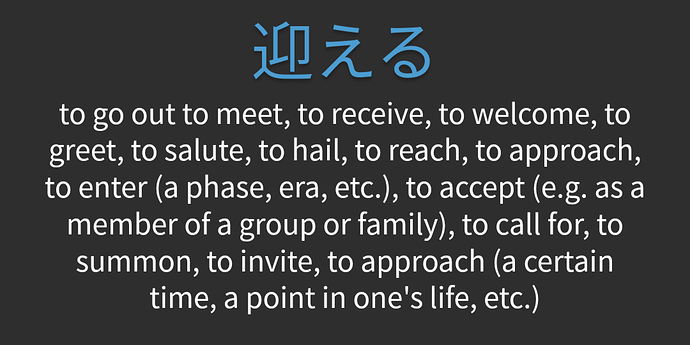Okay. Well, another thing I’ve been doing quite a bit of recently is using the Notes section to add in information about a vocab that will help me differentiate it, or add context to it. For example, for 参る, I have the following info in my Notes:
Humble 謙譲語.
参る, 詣る [まいる] (1) (v5r,vi) (hum,uk) to go; to come; to call (2) (v5r,vi) to be defeated; to collapse; to die (3) (v5r,vi) to be annoyed; to be nonplussed (4) (v5r,vi) to be madly in love (5) (v5r,vi) to visit (shrine, grave)
The first part highlights that 参る is a ‘humble’ word (specifically 謙譲語 (けんじょうご) ).
[Note: I spent a bunch of time adding additional vocab to my reviews in regards to different politeness levels, so I can finally understand the difference between ‘humble’, ‘polite’, ‘respectful’, ‘honorific’, etc. Best, IMO, to just learn the exact Japanese words for these different levels, rather than trying to memorize the approximate English translations.
I used Jisho.org to locate these words, and then searched for them in Bunpro using the Vocab Search page, and then added any specific vocab I wanted to (often they are not in the JLPT decks, or are higher level like N1).]
So, humble (謙譲語) means that it’s used by the speaker to refer to their own actions, in a very polite/respectful situation (speaking to someone ‘higher’ than yourself). So, you’d use 参る if the sentence is talking about like “I will visit my parents …”, and it’s written with です/ます and all that.
Basically, this is why you’re practising these vocabs in the first place, to learn these nuances.  So, part of it is just practising, and letting the SRS do its thing.
So, part of it is just practising, and letting the SRS do its thing.
The second part of the Notes is info copied from the “10ten Japanese Reader” plugin I have in Firefox. There’s a similar, more advanced plugin called Yomichan, but I just use the slightly simpler 10ten.
Anyway, the plugin pulls the definitions from the same source that powers Jisho.org, namely JMdict. So, I can hover over a Japanese word, it pops up the JMdict definition, and I can copy that and then paste it into the Notes section.
As you can see, often times the basic information is the same (same definitions), but the full info from JMdict includes more information, such as " (hum,uk) to go; to come; to call" includes the ‘hum’ tag in the brackets, indicating that it’s a humble (謙譲語) word.
That’s actually how/why I wrote the “Humble 謙譲語” at the top. Bunpro’s definitions alone weren’t enough to get that info, but 10ten / JMdict made it available, and that’s how I realized that one of the main nuances of 参る is its ‘humble’ politeness level. And that’s what helped me learn it, finally.
Sometimes I copy info from WaniKani, if it’s different from Bunpro or from the extra JMdict info. Sometimes I’ll use the Bold and Italics formatting tools in the Notes section to highlight a particular definition or two. Etc.
Basically, I use the Notes section to help me mnemonify (to invent a new word!) the vocab until it finally becomes unique enough in my mind that it has its own ‘place’ in my memory landscape.
Some words / groups-of-words are more difficult than others. But that’s the general strategy.
I tend to do a lot of side-research on different words if they cause difficulty. I’ll also look up similar words and add extra vocabs that are similar to a tricky one, so I’ll have extra practice ‘around’ the tricky word.
For example, 迎える (むかえる) seems like a really weird word (it did to me, anyway), and the kanji 迎 means ‘welcome’, but the word sometimes has the nuance of ‘to go out’, etc.
So, I noticed that むかえる looks a lot like む + かえる, and かえる is that oh so wonderful word that means a billion different things, but most of them have to do with ‘returning’ or ‘replacing’ or ‘changing’ things.
So, I focused on that. I did a bunch of searching for all the variants of かえる I could find, including transitive/intransitives, like かえす, かわる, and variants like かわり, etc. I found all the different kanji and added them and their most common words, too.
And then, once I had all these different variants, I just thought of むかえる as む + かえる, and so in my mind it became: "to ‘welcome’ by ‘going out to meet’ + ‘returning with the guest’ = む + かえる.
Later on you’ll come across things like the expression 迎えに行く (to go pick up; to go to welcome and return with) and 迎えに来る (to come pick up; to come to welcome and return (home) with).
I just add them all until it starts to puzzle itself out and make a place for itself in my memory landscape.
Admittedly, I’ve kind of overdone it with adding auxiliary vocabs. I probably don’t need so freaking many.  But hey, I actually know 迎える now (and many of its cousins)!
But hey, I actually know 迎える now (and many of its cousins)!
And in the meantime, I’ve zoomed through the N4 vocabs and I’m about 58% through N3 already, so I guess I’m doing something right. 
Hopefully some of those ideas help you out. At the end of the day, part of it will just be practice with the SRS, and another part will be exposure to the word outside of SRS, whether that be through explicit search/research as I’ve done, or better still through practice reading in the wild.
Eventually, your brain will figure it out. 



 So, part of it is just practising, and letting the SRS do its thing.
So, part of it is just practising, and letting the SRS do its thing.
